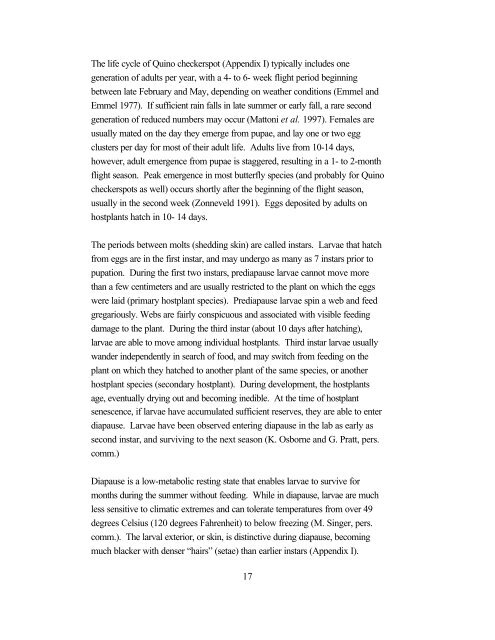Outline of Quino Recovery Plan - The Xerces Society
Outline of Quino Recovery Plan - The Xerces Society
Outline of Quino Recovery Plan - The Xerces Society
Create successful ePaper yourself
Turn your PDF publications into a flip-book with our unique Google optimized e-Paper software.
<strong>The</strong> life cycle <strong>of</strong> <strong>Quino</strong> checkerspot (Appendix I) typically includes one<br />
generation <strong>of</strong> adults per year, with a 4- to 6- week flight period beginning<br />
between late February and May, depending on weather conditions (Emmel and<br />
Emmel 1977). If sufficient rain falls in late summer or early fall, a rare second<br />
generation <strong>of</strong> reduced numbers may occur (Mattoni et al. 1997). Females are<br />
usually mated on the day they emerge from pupae, and lay one or two egg<br />
clusters per day for most <strong>of</strong> their adult life. Adults live from 10-14 days,<br />
however, adult emergence from pupae is staggered, resulting in a 1- to 2-month<br />
flight season. Peak emergence in most butterfly species (and probably for <strong>Quino</strong><br />
checkerspots as well) occurs shortly after the beginning <strong>of</strong> the flight season,<br />
usually in the second week (Zonneveld 1991). Eggs deposited by adults on<br />
hostplants hatch in 10- 14 days.<br />
<strong>The</strong> periods between molts (shedding skin) are called instars. Larvae that hatch<br />
from eggs are in the first instar, and may undergo as many as 7 instars prior to<br />
pupation. During the first two instars, prediapause larvae cannot move more<br />
than a few centimeters and are usually restricted to the plant on which the eggs<br />
were laid (primary hostplant species). Prediapause larvae spin a web and feed<br />
gregariously. Webs are fairly conspicuous and associated with visible feeding<br />
damage to the plant. During the third instar (about 10 days after hatching),<br />
larvae are able to move among individual hostplants. Third instar larvae usually<br />
wander independently in search <strong>of</strong> food, and may switch from feeding on the<br />
plant on which they hatched to another plant <strong>of</strong> the same species, or another<br />
hostplant species (secondary hostplant). During development, the hostplants<br />
age, eventually drying out and becoming inedible. At the time <strong>of</strong> hostplant<br />
senescence, if larvae have accumulated sufficient reserves, they are able to enter<br />
diapause. Larvae have been observed entering diapause in the lab as early as<br />
second instar, and surviving to the next season (K. Osborne and G. Pratt, pers.<br />
comm.)<br />
Diapause is a low-metabolic resting state that enables larvae to survive for<br />
months during the summer without feeding. While in diapause, larvae are much<br />
less sensitive to climatic extremes and can tolerate temperatures from over 49<br />
degrees Celsius (120 degrees Fahrenheit) to below freezing (M. Singer, pers.<br />
comm.). <strong>The</strong> larval exterior, or skin, is distinctive during diapause, becoming<br />
much blacker with denser “hairs” (setae) than earlier instars (Appendix I).<br />
17
















